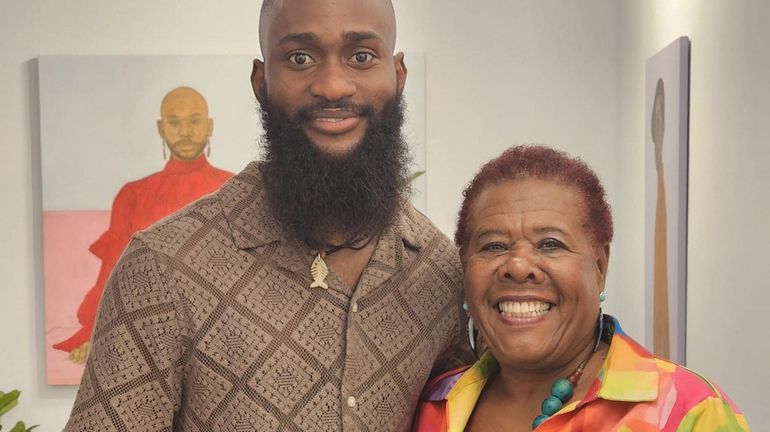Self-taught African artist Mayowa Nwadike gives insight into new Southampton exhibit

Nigerian artist Mayowa Nwadike, left, and Brenda Simmons, executive director of the Southampton African American Museum, at the opening reception for the artist's solo exhibition. Credit: Kilsi Bold
On a late night last summer, Nigerian artist Mayowa Nwadike sketched a vision for how he pictured his first solo exhibition.
Nwadike, 26, said he didn’t know that night, as he sketched in a New York City park, when his opportunity would arrive. But as the self-taught, mixed-media painter sat imagining or creating what it would look like, he mapped out a layout now featured in the Southampton African American Museum.
Only 25¢ for 5 months
On a late night last summer, Nigerian artist Mayowa Nwadike sketched a vision for how he pictured his first solo exhibition.
Nwadike, 26, said he didn’t know that night, as he sketched in a New York City park, when his opportunity would arrive. But as the self-taught, mixed-media painter sat imagining or creating what it would look like, he mapped out a layout now featured in the Southampton African American Museum.
Last month, that vision became reality when Nwadike’s first exhibition, “What Is, What Was and What Could Be” opened at the museum on North Sea Road in Southampton. The exhibition, which features 10 paintings that together tell a story of living in a place far from home, runs through July 8.
Nwadike, who moved to the United States in 2021, said he creates pieces that frequently touch on gender roles and toxic masculinity.
Brenda Simmons, the museum’s executive director, said an exhibition that opened in January featured two of Nwadike's paintings. Simmons, who said she loves to encourage young artists, said she was so impressed, she asked Nwadike if he ever had done a solo exhibition. When he said he hadn't, she told him: “Well, you will now.”
Nwadike said he spends up to four hours painting in the morning before his day job at a wine bar. He paints another hour or two after work in the Harlem apartment he shares with a fellow artist.
In Nigeria, Nwadike had been studying soil sciences at The Federal University of Technology Akure before dropping out in his third year to pursue art.
He recently discussed his exhibition and journey as an artist with Newsday. The interview was edited for clarity and length.
What drives your work?
I’m recreating experiences, moments in time that I’ve lived through. I look for a way to create a bridge between my experience in Africa and the experience in New York City. One of the major goals in creating that bridge is to unite Africans in Africa and the African American experience to bring together a sense of unison.
What issues do you explore in your art?
Social issues like gender or toxic masculinity, especially in a Black society. It creates a safe space for Black men to express themselves to fellow Black men without being ridiculed or being seen as weak or being seen as less of a man.
What was the biggest adjustment moving from Nigeria to New York?
Coming here, it’s like there are reminders constantly that you are Black and I’ve had some experiences where I was racially profiled, addressed wrongly because of my skin color and that kind of left a sour taste in my mouth.
How did you select work for the exhibition?
Each body of work informs the next body of work. It’s kind of like watching your favorite TV show unfold through different characters. I kind of had an idea of what the emotions were that I wanted people to feel. I wanted the show to start happy, go sad, take to a more spiritual, godlike feel, then go back sad and end up with a warm embrace. I wanted people to connect with the story I was trying to tell.
How will a solo exhibition help move your career forward?
It gives me a lot of renewed confidence because it’s not easy leaving everything you’ve known. The goal of my art is to communicate, to pass something across to the viewer. The fact that that happened in my case gave me encouragement to want to keep pushing no matter how tough it gets.
How did you come up with the exhibition title?
What is, what was and what could be — that is a question I always ask myself with each painting. Every painting I’d say is informed by these three questions. How the past informs the present and how the present informs the future. I’d say the title of the show is to inform the audience how time is not just a linear experience.
'It's disappointing and it's unfortunate' Suffolk Police Officer David Mascarella is back on the job after causing a 2020 crash that severely injured Riordan Cavooris, then 2. NewsdayTV's Andrew Ehinger and Newsday investigative reporter Paul LaRocco have the story.